There is a professional meta moment that occurs once in a blue moon. It happens when a doctor cures her own cold, when an electrician replaces his circuit breaker, and when a data scientist studies the evolution of data science. With the profiles of 125,000 data professionals on LinkedIn, we can track how data science is changing! Oddly enough, the stories of where they come from and where they are going are diverging! Let’s take a look.
The gorgeous data set we’ll use is LinkedIn’s massive professional network:
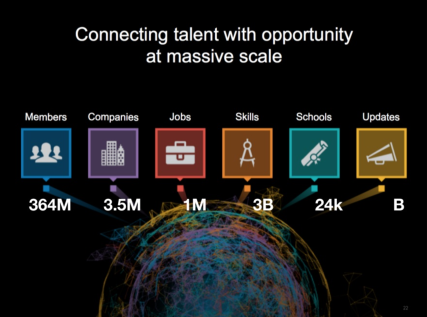
Data to work with. It’s big. After job title standardization there are 125k data professionals with job titles ranging from data engineering, data science, to data analysts. (LinkedIn Data)
Famously, data science is an increasingly popular field with exponential growth in the past few years. However, degrees in data science are only now graduating students. So where did all the current 125k data practitioners come from? If you break down the distribution of degrees obtained by data professionals, computer science is the leader. However, the big take away is that the top 10 degrees account for only a quarter of all degrees held by data professionals!
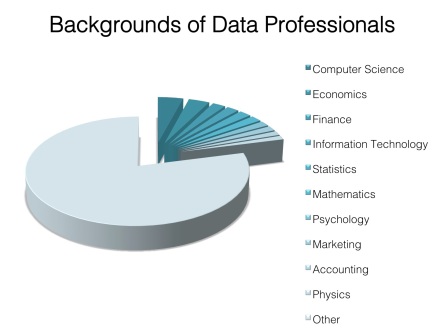
Top 10 degrees earned by data professionals.
In fact, they hold are over 2,000 types of degrees. Of these, 16% are unique, where exactly one person has obtained that particular degree and become a data professional. A sample of the long tail yields some esoteric, but relevant fields I can see benefiting from a data scientist’s work:
- Oral Surgery
- Phytopathology (study of plant diseases)
- Wedding Planning
- Ground Transportation
- Library Sciences
- Turfgrass Management
- Embryology
- Fire Fighting
- Stagecraft
- Art Conservation
Interesting! How is this diversity of backgrounds changing over time? We can look at the share of data professionals coming from the top 10 degree programs:

It’s a bumpy trajectory, but over time, the trend is higher. In other words, where data professionals come from is becoming more homogenous. With the increase in data science masters programs and incubators, I expect this trend to continue. Growth is not evenly experienced by each degree and we can look at changes within the top 10 backgrounds. Some are steadily gaining and some are rapidly loosing prominence.
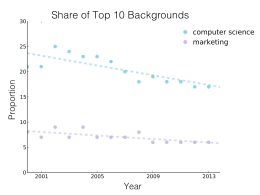
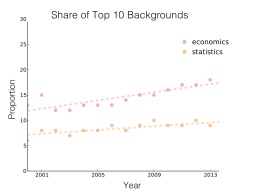
For those in Silicon Valley, this probably matches your on the ground experience. Originally, people already at companies stepped into data science roles on an as needed basis. Computer scientists and marketers were in common supply. Now that companies are hiring directly into data science, roles economists and statisticians are on the rise.
Okay, that’s where data professionals come from. Where do they go? We can perform a very similar analysis and arrive at the conclusions:
- The top 10 industries have more than a quarter of data professionals, but still not a majority.
- Over time, the top 10 are clearly loosing dominance.
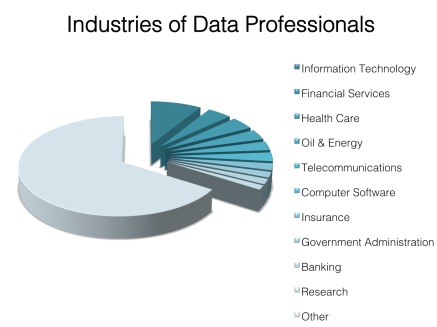
Top 10 industries for data professionals.

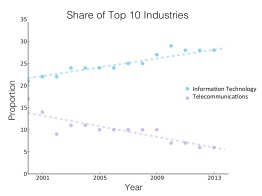
In short, where data professionals are hired is becoming increasingly diverse. Let us put these two trends together:
- Homogenization of Sources of Data Professionals
- Diversification of Industry Destinations of Data Professionals
Side by side, these trends seem at odds, with a potential down side. Consider a newly minted data scientist with a computer science background hired into an art conservation company. It’s possible their first year in the industry is spent using big data to confirm what conservationists already know from centuries of domain expertise. It would be a shame for such talent and resources to be spent re-inventing the wheel. A possible solution can be borrowed from Applied Math. My recommendation to the next generation of data scientists is learn your craft, learn your stats, learn your map-reduce, learn your visualizations. But for fun, couple your studies with classical courses from an application field you are interested in. After all, some of the happiest data scientists I know, use their skills to advance their passions in housing, movies, and fashion.
All results have been peer reviewed internally at LinkedIn.
Where possible numbers have been verified with external sources.
Results were presented in a talk to the 2015 Spring Data Insights Fellows. The talent in those incubators continues to astound me.
Outstanding article! I plan to send it to everyone I know who is currently attending University.